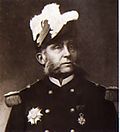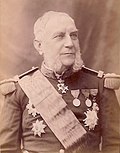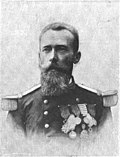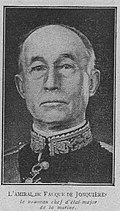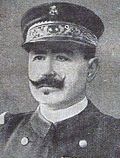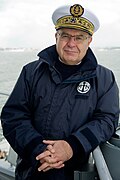Chief of Staff of the French Navy
 From Wikipedia - Reading time: 19 min
From Wikipedia - Reading time: 19 min
| Chief of Staff of the French Navy | |
|---|---|
| Chef d'État-Major de la Marine (fr) | |
 | |
since 1 September 2023 | |
| Style | Monsieur le Chef d'État-Major de la Marine |
| Abbreviation | C.E.M.M. |
| Member of | Chiefs of Staff Committee |
| Reports to | Chief of the Defence Staff |
| Seat | Hexagone Balard, Paris |
| Appointer | President of the Republic Requires the Prime Minister's countersignature |
| Formation | 1871 |
| First holder | Jules Krantz |
| Deputy | Major General of the Navy |
| Website | www.defense.gouv.fr |
The Chief of the Naval Staff (French: Chef d’état-major de la Marine, pronounced [ʃɛf deta maʒɔʁ də la maʁin], abbr. CEMM) is a French general officer, adviser to the Chief of the Defence Staff for the French Navy and responsible to the Minister of the Armed Forces for preparing the Navy for its engagement. Since 1 September 2023, the Chief of the Naval Staff has been Admiral Nicolas Vaujour.
Main powers
[edit]The Chief of the Naval Staff is the top representative of the French Navy.
He advises and assists the Chief of the Defence Staff. He provides him with Navy-specific expertise.
He maintains bilateral relations with foreign navies. He participates in inter-administrative bodies in the field of State action at sea.
He has authority over the Navy General Staff (French: Etat-major de la Marine, acronym: EMM), over the Navy Military Personnel Directorate (French: Direction du personnel militaire de la Marine, acronym: DPMM), as well as over all the commands, directorates and services that make up the French Navy.
He ensures the preparation of the naval forces. As such, he is responsible for instruction and training, as well as maintenance of operational readiness. He develops the concepts and doctrines for the employment of naval forces. He reports to the Chief of the Defence Staff on the availability of assets and the operational readiness of the naval forces.
Regarding capabilities, the Chief of the Naval Staff develops the French Navy's military requirements. He defines support and infrastructure needs. He is responsible for the operational evaluation of new equipment. He decides their commissioning and their withdrawal from service at the end of their life.
In terms of human resources, regarding the military personnel of the French Navy, he is responsible for their recruitment, initial and continuous training, discipline, morale and wellbeing, professional and career paths, as well as management of the workforce, jobs and skills. Regarding civilian personnel under his authority, he expresses the needs in terms of employment, manpower and skills. He takes part in the implementation of the ministerial policy concerning civilian personnel and participates in social dialogue bodies.
He has responsibilities in terms of risk management and nuclear safety.
Authority and command
[edit]The authority of the Chief of the Naval Staff is exercised over several bodies:
- The Navy General Staff provides general management for the following entities, under the direction of the Major General of the Navy (French: Major général de la Marine, acronym: MGM) and through its seven bureaux (performance and synthesis, support and finance, plans and programs, naval air operations, international relations, nuclear affairs and risk management, human resources):
- Navy Military Personnel Directorate, headed by a Vice-Admiral (acronym: DPMM);
- Major force commands:
- Vice-Admiral "ALFAN", commanding the Naval Action Force (FAN);
- Vice-Admiral "ALFOST", commanding the Strategic Oceanic Force (FOST);
- Commodore "ALAVIA", commanding the naval aviation force (AVIA);
- Commodore "ALFUSCO", commanding the force of marines and commandos (FORFUSCO);
- Maritime zone commanders:
- Vice-Admiral, maritime prefect of the Mediterranean;
- Vice-Admiral, maritime prefect of the Atlantic;
- Vice-Admiral, maritime prefect of the English Channel and the North Sea;
- Commodore "ALPACI", commanding the French Pacific Fleet and the armed forces in French Polynesia;
- Commodore "ALINDIEN", commanding the Indian Ocean Maritime Zone (ZMOI) and the French Maritime Forces in the Indian Ocean;
- Commodore "COMSUP FAA", commanding the French Armed Forces in the West Indies.
- The following services and departments:
- Inspectorate of the Navy (not to be confused with the General Inspectorate of the Armed Forces, which reports to the Minister of the Armed Forces);
- Navy Outreach Delegate;
- Permanent Commission for Fleet Vessel Programs and Testing;
- Navy Centre for Strategic Studies;
- Navy Public Relations Office (SIRPA Marine);
- Navy Logistics Service;
- Permanent Council for Boating Safety of the Navy;
- Permanent Council for Air Safety of the Navy;
- Permanent Secretariat of the Council for the Military Services of the Navy;
- Inspector of the health service for the Navy;
He chairs the board of directors of the Hydrographic and Oceanographic Service of the Navy (French: Service hydrographique et océanographique de la Marine, acronym: SHOM) and supervises the French Naval Academy on behalf of the Minister of the Armed Forces.
History
[edit]Before the First World War, the Chief of the Naval Staff was above all the head of the military cabinet of the Minister of the Navy, and this mode of operation is the source of the name used; the officer who had effective authority over the Navy was then the admiral commanding the naval army, sometimes unofficially referred to as "amiralissime", in reference to the title of "généralissime" used at the time in the Army.
The First World War called all this into question, because an immense work of reorganisation had to be carried out at the headquarters in "rue Royale"a to conduct a long-lasting industrial maritime war and to be able to face the new threats posed by German submarines and underwater mines: a sort of "second staff" was even created, called the "directorate general for underwater warfare" (French: Direction générale de la guerre sous-marine, acronym: DGGSM) with sometimes overlapping areas of action; this observed redundancy logically led to the dissolution of the DGGSM at the end of the war and the attribution of its many prerogatives to the offices of the Navy General Staff.
In order to have a system allowing a flexible transition between peacetime — period of preparation — and wartime — period of action — the Vice-Admiral Chief of the Navy General Staff becomes, in the 1920s, the designated commander of the French maritime forces in the event of war, and the staff tasks fall in such circumstances to the Major General of the Navy, his first deputy in time of peace.
From 26 August 1939 to 6 June 1943, the organisation of the French Navy no longer included a general staff, but instead a "staff of the French maritime forces" which acted as such for the time of war. Admiral Darlan thus became commander-in-chief of the French maritime forces before being called to other functions in February 1941 in Vichy France.
After the Second World War, the gradual disappearance of the portfolio of Minister of the Navy led to entrusting part of the Minister's prerogatives to the Chief of the Naval Staff. However over time these prerogatives were taken over at the "joint" level by the staff of the armed forces and its chief: the Chief of the Defence Staff. The Chief of the Naval Staff thus lost his responsibilities for directing maritime operations to the Chief of the Defence Staff in 1971b.
In the 2000s, a large part of the organic prerogatives – force preparation – was again transferred to the Chief of the Defence Staff, but the Chief of the Naval Staff remained his main adviser regarding the preparation and employment of the Navy.
Admiral Bernard Louzeau decided at the end of the 1980s to replace the emblem of the French Navy, "a gold anchor intertwined with a cable", by a logo representing "a white ship’s bow with two blue and red waves". Admiral Pierre-François Forissier decided to provide the Navy with an anthem whose lyrics were written in 2011 by Lieutenant Christian Beauval and the music by the Chief of Music of the Armed Forces Didier Descamps, Chief of Music of the Brest fleet crews.
List of chiefs
[edit]The following is a list of chiefs that served under the Third Republic, the French State, the Fourth Republic and the Fifth Republic:
Third Republic
[edit]French State
[edit]| No. | Portrait | Rank & Name | Term | Minister | Commander-in-Chief | Ref.[a] | ||
|---|---|---|---|---|---|---|---|---|
| Took office | Left office | Duration | ||||||
| (42) | 
|
Amiral[f] François Darlan |
25 June 1939 | 2 September 1941 | 2 years, 69 days | César Campinchi François Darlan |
Albert Lebrun Philippe Pétain |
[44] - |
| 43 | 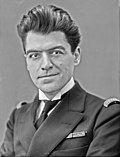
|
Contre-amiral Gabriel Auphan |
2 September 1941 | 18 November 1942 | 1 year, 77 days | François Darlan | Philippe Pétain | [45] - |
| 44 | 
|
Vice-amiral d'escadre Maurice Le Luc |
21 November 1942 | 1 April 1943 | 131 days | Jean Abrial | Philippe Pétain | [46] - |
Fourth Republic
[edit]| No. | Portrait | Rank & Name | Term | Minister[g] | Commander-in-Chief | Ref.[a] | ||
|---|---|---|---|---|---|---|---|---|
| Took office | Left office | Duration | ||||||
| 45 | 
|
Vice-amiral d'escadre[h] André Lemonnier |
7 August 1943 | 28 May 1950 | 6 years, 294 days | Philippe Auboyneau Louis Jacquinot [...] Paul Ramadier René Pleven |
Charles de Gaulle Félix Gouin Georges Bidault Léon Blum Vincent Auriol |
[47] - |
| 46 | 
|
Vice-amiral Robert Battet |
28 May 1950 | 14 July 1950† | 47 days | René Pleven Jules Moch |
Vincent Auriol | [48] - |
| 47 | 
|
Vice-amiral Roger-Gabriel Lambert |
10 August 1950 | 26 October 1951 | 1 year, 77 days | Jules Moch Georges Bidault |
Vincent Auriol | [49] - |
| 48 | 
|
Amiral Henri Nomy |
26 October 1951 | 19 May 1960 | 8 years, 206 days | Georges Bidault René Pleven [...] Pierre Guillaumat Pierre Messmer |
Vincent Auriol René Coty Charles de Gaulle |
- - |
Fifth Republic
[edit]See also
[edit]Notes
[edit]- ^ a b c d Upper references are the official decree of nomination in French. Lower references are press articles in English.
- ^ a b Capitaine de vaisseau at the time of his appointment, promoted to Contre-amiral while in office.
- ^ a b Appointed "Chef d'état-major général avec le titre faisant fonction"; faisant fonction is a locution indicating that an officer is holding an office usually attached to a higher rank.
- ^ a b c Contre-amiral at the time of his appointment, promoted to Vice-amiral while in office.
- ^ Vice-amiral at the time of his appointment, promoted to Amiral and bearing the title Amiral de la flotte while in office.
- ^ From 25 June 1939, his full style was The admiral of the Fleet, Commander-in-chief of the French Naval Forces.
- ^ The Minister of the Navy was responsible until 1947, after which the Minister of the Armed Forces took over.
- ^ Contre-amiral at the time of his appointment, promoted to Vice-amiral and Vice-amiral d'escadre while in office.
References
[edit]- ^ "Marques, honneurs, saluts et visites dans les forces navales et à bord des bâtiments de la marine militaire". gallica.bnf.fr (in French). 10 August 1939. Retrieved 29 February 2020.
- ^ Government of the French Republic (8 March 1871). "Décret portant affectation d'un officier général". gallica.bnf.fr (in French). Retrieved 29 February 2020.
- ^ Government of the French Republic (3 June 1873). "Décret portant affectation d'un officier général". gallica.bnf.fr (in French). Retrieved 29 February 2020.
- ^ Government of the French Republic (30 September 1874). "Décret portant affectation d'un officier général". gallica.bnf.fr (in French). Retrieved 29 February 2020.
- ^ Government of the French Republic (11 March 1876). "Décret portant affectation d'un officier général". gallica.bnf.fr (in French). Retrieved 29 February 2020.
- ^ Government of the French Republic (30 September 1877). "Décret portant affectation d'un officier général". gallica.bnf.fr (in French). Retrieved 29 February 2020.
- ^ Government of the French Republic (11 February 1879). "Décret portant affectation d'un officier général". gallica.bnf.fr (in French). Retrieved 29 February 2020.
- ^ Government of the French Republic (1 August 1880). "Décret portant affectation d'un officier général". gallica.bnf.fr (in French). Retrieved 29 February 2020.
- ^ Government of the French Republic (16 November 1881). "Décret portant affectation d'un officier général". gallica.bnf.fr (in French). Retrieved 29 February 2020.
- ^ Government of the French Republic (31 January 1882). "Décret portant affectation d'un officier général". gallica.bnf.fr (in French). Retrieved 29 February 2020.
- ^ Government of the French Republic (28 February 1883). "Décret portant affectation d'un officier général". gallica.bnf.fr (in French). Retrieved 29 February 2020.
- ^ Government of the French Republic (13 July 1885). "Décret portant affectation d'un officier général". gallica.bnf.fr (in French). Retrieved 29 February 2020.
- ^ Government of the French Republic (9 January 1886). "Décret portant affectation d'un officier général". gallica.bnf.fr (in French). Retrieved 29 February 2020.
- ^ Government of the French Republic (31 March 1887). "Décret portant affectation d'un officier général". gallica.bnf.fr (in French). Retrieved 29 February 2020.
- ^ Government of the French Republic (1 June 1887). "Décret portant affectation d'un officier général". gallica.bnf.fr (in French). Retrieved 29 February 2020.
- ^ Government of the French Republic (15 December 1887). "Décret portant affectation d'un officier général". gallica.bnf.fr (in French). Retrieved 29 February 2020.
- ^ Government of the French Republic (12 November 1889). "Décret portant affectation d'un officier général". gallica.bnf.fr (in French). Retrieved 29 February 2020.
- ^ Government of the French Republic (23 January 1892). "Décret portant affectation d'un officier général". gallica.bnf.fr (in French). Retrieved 29 February 2020.
- ^ Government of the French Republic (21 September 1894). "Décret portant affectation d'un officier général". gallica.bnf.fr (in French). Retrieved 29 February 2020.
- ^ Government of the French Republic (7 November 1895). "Décret portant affectation d'un officier général". gallica.bnf.fr (in French). Retrieved 29 February 2020.
- ^ Government of the French Republic (15 June 1896). "Décret portant affectation d'un officier général". gallica.bnf.fr (in French). Retrieved 29 February 2020.
- ^ Government of the French Republic (7 July 1898). "Décret portant affectation d'un officier général". gallica.bnf.fr (in French). Retrieved 29 February 2020.
- ^ Government of the French Republic (7 July 1899). "Décret portant affectation d'un officier général". gallica.bnf.fr (in French). Retrieved 29 February 2020.
- ^ Government of the French Republic (27 April 1900). "Décret portant affectation d'un officier général". gallica.bnf.fr (in French). Retrieved 29 February 2020.
- ^ Government of the French Republic (31 January 1902). "Décret portant affectation d'un officier général". gallica.bnf.fr (in French). Retrieved 29 February 2020.
- ^ Government of the French Republic (18 February 1904). "Décret portant affectation d'un officier général". gallica.bnf.fr (in French). Retrieved 29 February 2020.
- ^ Government of the French Republic (28 January 1905). "Décret portant affectation d'un officier général". gallica.bnf.fr (in French). Retrieved 29 February 2020.
- ^ Government of the French Republic (17 August 1905). "Décret portant affectation d'un officier général". gallica.bnf.fr (in French). Retrieved 29 February 2020.
- ^ Government of the French Republic (4 August 1909). "Décret portant affectation d'un officier général". gallica.bnf.fr (in French). Retrieved 29 February 2020.
- ^ Government of the French Republic (24 January 1911). "Décret portant affectation d'un officier général". gallica.bnf.fr (in French). Retrieved 29 February 2020.
- ^ Government of the French Republic (10 January 1912). "Décret portant affectation d'un officier général". gallica.bnf.fr (in French). Retrieved 29 February 2020.
- ^ Government of the French Republic (8 January 1913). "Décret portant affectation d'un officier général". gallica.bnf.fr (in French). Retrieved 29 February 2020.
- ^ Government of the French Republic (22 May 1914). "Décret portant affectation d'un officier général". gallica.bnf.fr (in French). Retrieved 29 February 2020.
- ^ Government of the French Republic (4 December 1914). "Décret portant affectation d'un officier général". gallica.bnf.fr (in French). Retrieved 29 February 2020.
- ^ Government of the French Republic (8 June 1915). "Décret portant affectation d'un officier général". gallica.bnf.fr (in French). Retrieved 29 February 2020.
- ^ Government of the French Republic (4 March 1916). "Décret portant affectation d'un officier général". gallica.bnf.fr (in French). Retrieved 29 February 2020.
- ^ Government of the French Republic (15 April 1919). "Décret portant affectation d'un officier général". gallica.bnf.fr (in French). Retrieved 29 February 2020.
- ^ Government of the French Republic (3 February 1920). "Décret portant affectation d'un officier général". gallica.bnf.fr (in French). Retrieved 29 February 2020.
- ^ Government of the French Republic (25 January 1921). "Décret portant affectation d'un officier général". gallica.bnf.fr (in French). Retrieved 29 February 2020.
- ^ Government of the French Republic (22 July 1924). "Décret portant affectation d'un officier général". gallica.bnf.fr (in French). Retrieved 29 February 2020.
- ^ Government of the French Republic (10 January 1928). "Décret portant affectation d'un officier général". gallica.bnf.fr (in French). Retrieved 29 February 2020.
- ^ Government of the French Republic (16 February 1931). "Décret portant affectation d'un officier général". gallica.bnf.fr (in French). Retrieved 29 February 2020.
- ^ Government of the French Republic (5 November 1936). "Décret portant affectation d'un officier général". gallica.bnf.fr (in French). Retrieved 29 February 2020.
- ^ Government of the French Republic (24 June 1939). "Décret portant appelation avec prise de rang". gallica.bnf.fr (in French). Retrieved 29 February 2020.
- ^ Government of the French State (1 September 1941). "Décret portant affectation d'un officier général". gallica.bnf.fr (in French). Retrieved 29 February 2020.
- ^ Government of the French State (20 November 1942). "Décret portant affectation d'un officier général". gallica.bnf.fr (in French). Retrieved 29 February 2020.
- ^ Government of the French Republic (6 August 1943). "Décret portant affectation d'un officier général". gallica.bnf.fr (in French). Retrieved 29 February 2020.
- ^ Government of the French Republic (27 May 1950). "Décret portant affectation d'un officier général". legifrance.gouv.fr (in French). Retrieved 29 February 2020.
- ^ JORF #190 - P8411 - 11 August 1950
- ^ JORF #117 - P4537 - 19 May 1960
- ^ Government of the French Republic (8 July 1974). "Décret portant affectation d'un officier général". legifrance.gouv.fr (in French). Retrieved 29 February 2020.
- ^ Government of the French Republic (18 June 1976). "Décret portant affectation d'un officier général". legifrance.gouv.fr (in French). Retrieved 29 February 2020.
- ^ Government of the French Republic (2 June 1982). "Décret portant affectation d'un officier général". legifrance.gouv.fr (in French). Retrieved 29 February 2020.
- ^ Government of the French Republic (23 December 1986). "Décret portant affectation d'un officier général". legifrance.gouv.fr (in French). Retrieved 29 February 2020.
- ^ Government of the French Republic (7 November 1990). "Décret portant affectation d'un officier général". legifrance.gouv.fr (in French). Retrieved 29 February 2020.
- ^ Government of the French Republic (9 May 1994). "Décret portant affectation d'un officier général". legifrance.gouv.fr (in French). Retrieved 29 February 2020.
- ^ Government of the French Republic (9 April 1999). "Décret portant affectation d'un officier général". legifrance.gouv.fr (in French). Retrieved 29 February 2020.
- ^ Government of the French Republic (31 May 2001). "Décret portant affectation d'un officier général". legifrance.gouv.fr (in French). Retrieved 29 February 2020.
- ^ "Honours for elite snubbed by De Gaulle". The Guardian. 7 June 2004. Retrieved 29 February 2020.
- ^ Government of the French Republic (13 May 2005). "Décret portant affectation d'un officier général". legifrance.gouv.fr (in French). Retrieved 29 February 2020.
- ^ "French Navy Chief visits India". French Embassy in New Delhi. 8 December 2007. Retrieved 29 February 2020.
- ^ Government of the French Republic (21 January 2008). "Décret portant affectation d'un officier général". legifrance.gouv.fr (in French). Retrieved 29 February 2020.
- ^ Government of the French Republic (24 June 2011). "Décret portant affectation d'un officier général". legifrance.gouv.fr (in French). Retrieved 29 February 2020.
- ^ "French Navy Plans Around Ship Sale to Egypt". DefenseNews. 11 February 2015. Retrieved 29 February 2020.
- ^ Government of the French Republic (7 July 2016). "Décret portant affectation d'un officier général". legifrance.gouv.fr (in French). Retrieved 29 February 2020.
- ^ "France launches new nuclear-powered attack submarine". France24. 12 July 2019. Retrieved 29 February 2020.
- ^ Government of the French Republic (22 July 2020). "Décret portant affectation d'un officier général". legifrance.gouv.fr (in French). Retrieved 10 August 2020.
 KSF
KSF

